Puno
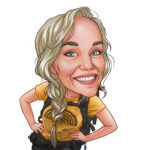
By Jaimy de Vries
Puno is a city at lake Titicaca. It’s a gateway to visit one of the islands on the lake. On these islands live communities that still live like the traditions more than 500 years ago. It’s a great way to get to learn and get a taste of the old Peruvian traditions, traditions that go back before the Inca empire. It was inspiring to see how happy they are, just by living a simple life in a loving community.
After a 7 hours bus ride we arrived in Puno where we stayed for 2 days. Puno is a colonial city at the Titicaca lake and is the gateway for tours to the lake. Lake Titicaca is a special place because there is a big community living on the lake, on floating islands! When we visited Puno of course we couldn’t leave before we visited one of these communities. So we booked a full day tour to Uros and Taquille for the next day. It is possible to book a 2 day trip and stay at the locals on one of the floating islands. That would be quite unique, but we didn’t had the time for that because the tour starts early in the morning and we arrived in the afternoon.
After booking our tour at the hostel we walked to the city center of Puno. The first streets we walked into we laughed and I said to Amy ” Why do they have so many photocopy stores?” There were like six of these shops in every street! The city is overwhelmed with them. “How can they survive?” asked Amy? “No idea!!“. Its funny and strange at the same time. There were so many car gases in the city. We felt like we were suffocating. We arrived at the main plaza and bought an ice cream. Because there were no cars driving here the air was much cleaner. We sat at the stairs before the cathedral de Puno. We sat here for 3 hours and could’ve stayed much longer. There were many people walking by and you see lots of pigeons on the main square. There was a family selling maize seeds to feed the pigeons. There was always someone feeding the pigeons. I did it too and loved doing this. They come very close. Sometimes they flew on my hand to eat some of the seeds. It was an amazing experience, to see them come so close.

Main square
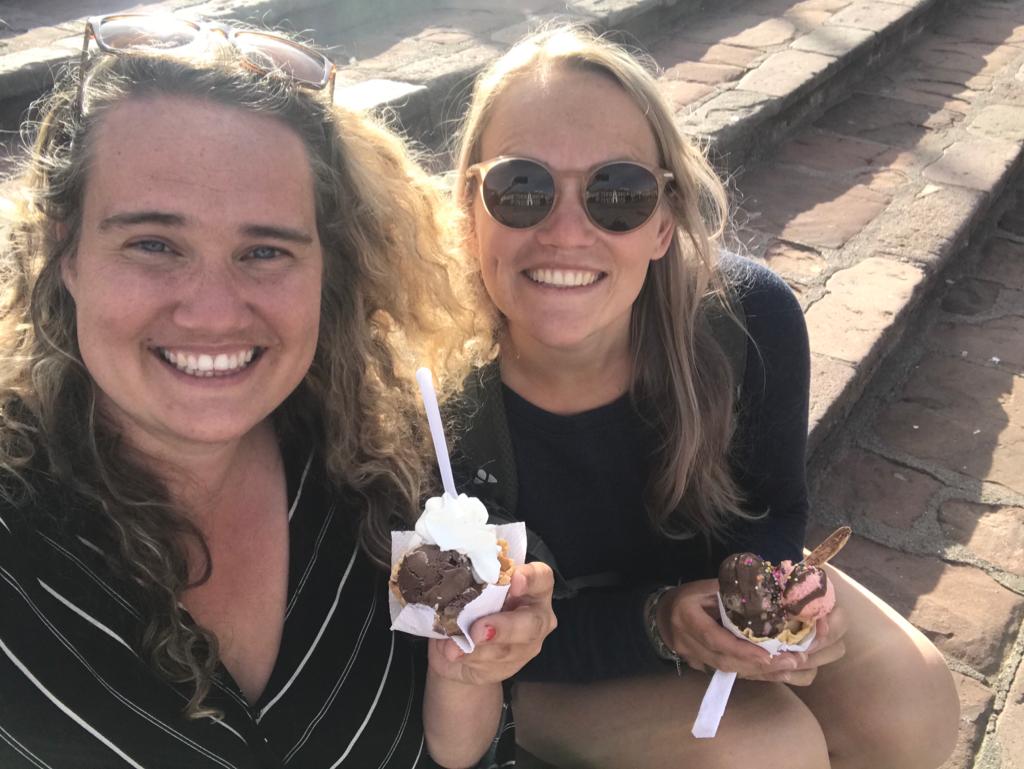
Having an ice cream

Pigeon’s eating of your hand
World highest largest lake
On the second day we went on a tour to the Titicaca lake. The Titicaca lake is the world’s largerest highest lake in the world. It feels more like an ocean because of the size and its waves. It’s at an elevation of 3,812 meters (12,507 feet), more than 190 kilometers (120 miles) long and 80 kilometers (50 miles) wide. It straddles the boundary between Peru and Bolivia. The guide made a joke that titi (means Puma ) is for Peru and kaka = shit (caca actually means mountain, but he referend to kaka) is for Bolivia.
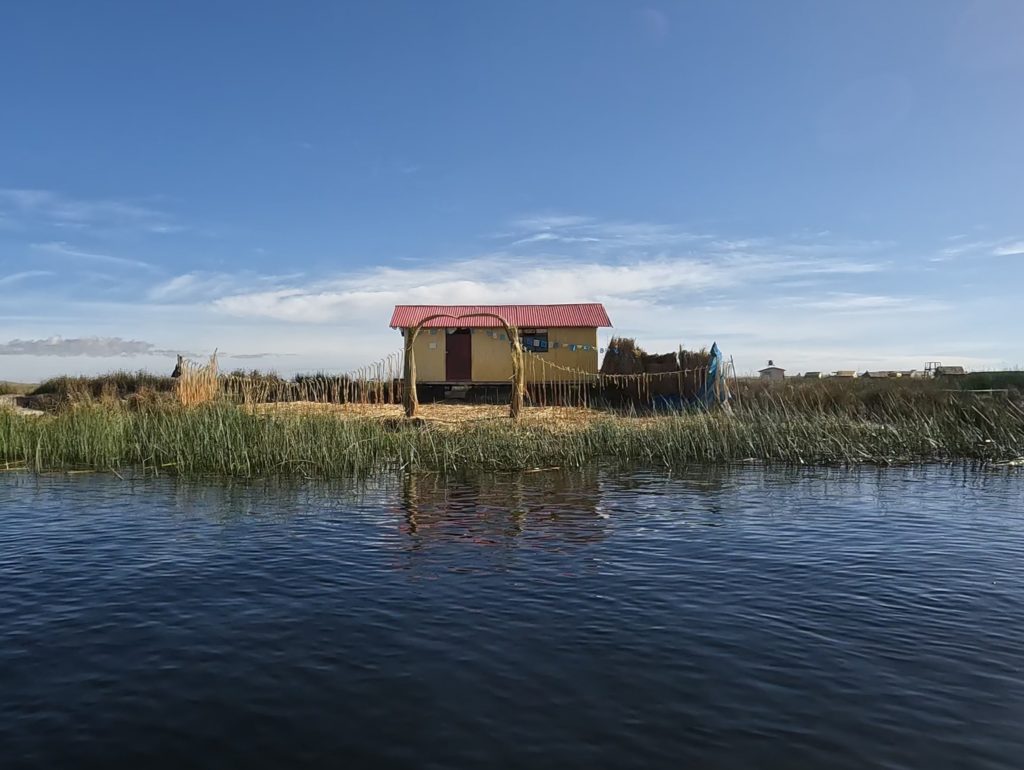
Titicaca lake
Uros
At the lake there are communities who are living here for a long time. They lived here before the inca-time. They escaped the mainland from aggressive mainland groups like the Incas. We visited the community at the Uros islands. They live on floating islands that they build themselves. The lake is sacred for them. They call the lake “mama cocha” what means mother lake. They are grateful, because they live on and from the lake.
They make everything from reed, their own land aka floating islands, their houses and souvenirs. They even eat the reed. I tried some and it tastes like celery.
But the people are also very good fishers. They build there own reed ships and hunt for fish like trout. They also hunt for ducks and their eggs. They drink the water from the lake, even though it doesn’t look very clean. But they’re adjusted to the minerals in the water. We probably get stomached from that. So eating the reed that grew on this water, was a risk. But I’m still alive and writing this article without having any shitty problem.
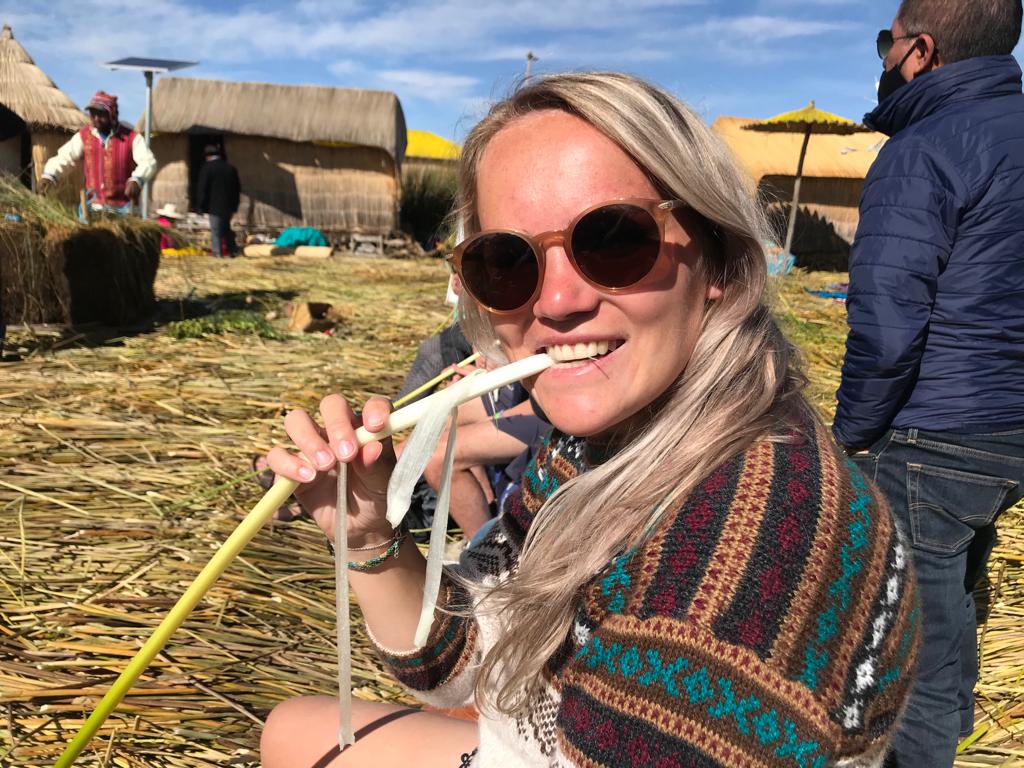
Eating reed
After a 30 minute boat trip we arrived at Uros at one of their islands called Condor. It turns out there are 100 islands and 2000 people living in the Uros community. One of the island contains a very small clinic and primary school. When we arrived at the island Condor we got welcomed by their own language called Aimara. They were very happy to see us. They wore very colorful clothing. We stepped out of the boat. It was very strange to walk on the reed floor. You could feel the waves from the lake. It was actually quite comfortable…but I think that’s just me, I love water. My mum would be scared as hell.
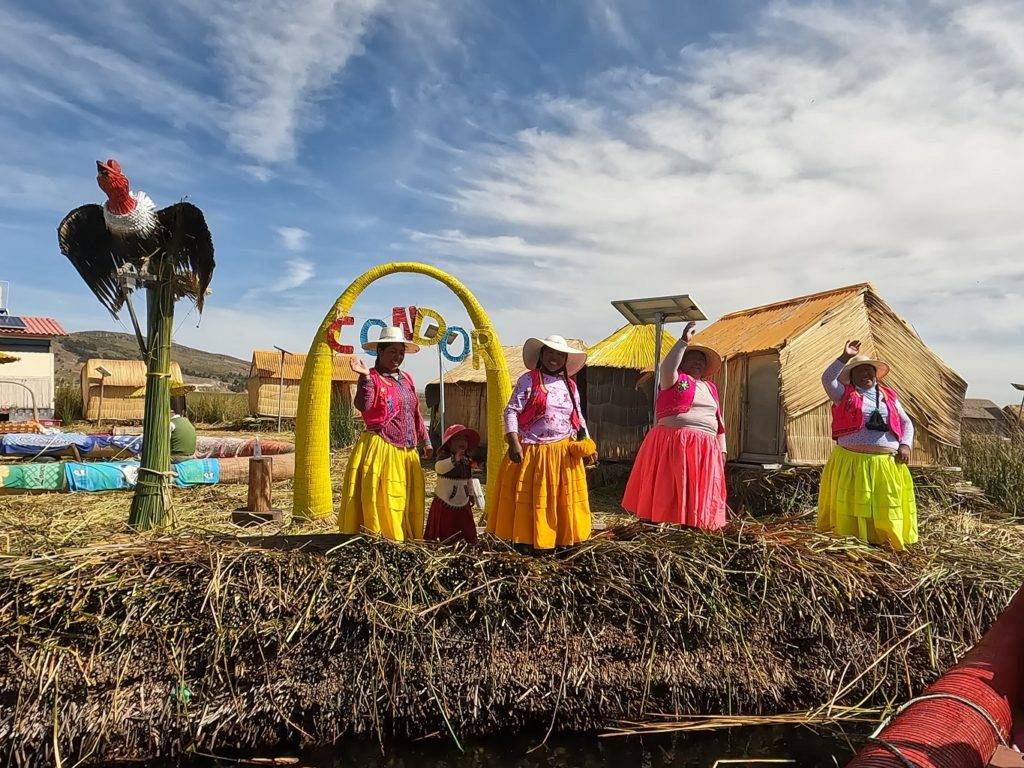
One of the islands made out of reed
When we were on the island we got an explanation how they live here and how they build their floating island. At each island there lives a family or people who are related to the family. The island we visited is 22 years old, it took them two years to build it. It was really interesting to hear how they’re making the floating islands. With a very big sew they cute blocks of reed and their roots from the ground in the lake. Later they connect these blocks of reed and root with poles and rope. Then they put big layers of reed on these blocks. Then they anker the island with rope and heaving rocks that they put in the lake. This floating island has 21 blocks of reed&roots and 12 ankers.

How they build an island
Nowadays they live a little bit like the modern society. They have electricity by solar panels, build a bathroom with a septum tank and they try to earn money by selling souvenirs and activities to tourist. In that way they can buy stuff in the city Puno. So the islands became a tourist attraction and that’s how they earn their money now. Quite a loss if you ask me. But otherwise I probably couldn’t visited these islands. So you won’t hear me complaining. I helped them out a little and bought a wooden flute with beautiful carvings. She said its a flute for babies. Well you need to learn on a small one right?
I got to see one of the houses from the inside. It had one large bed and the walls were covered of colorful clothing. Of course it turned out to be a house of one of the ladies. The lady of the house asked us if we wanted to get dressed too “Of course!!”. After dressing up it felt we were a part of the island. After our visit on this island we went on a reed boat to another island. The boat was beautiful and it was a funny experience. After that we went back on the speedboat, off to another community on the island Taquile.
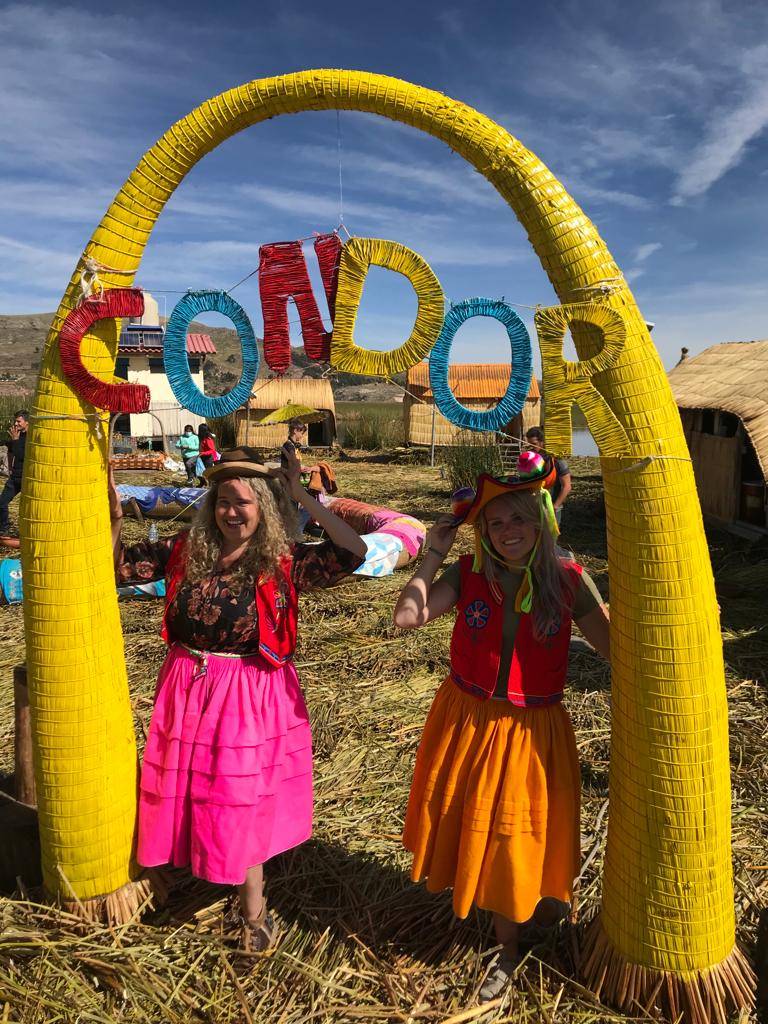
How they build an island

How they build an island
Taquile
Then we headed to Taquile, not to confuse with tequilla. It was a 2 hour boat ride to reach this island. It’s located in the middle of the Peruvian half of Lake Titicaca. Taquile has beautiful natural landscape with steep slopes and stone paths that offers a breathtaking view over the dazzeling blue of the lake Titicaca. The water here was for sure much clearer than it was in Uros. But perhaps what Isla Taquile is most well known for today is its weaving tradition.
Weaving is, of course, an integral part of local culture in many parts of Peru. It is a way for indigenous peoples to represent their history and society with geometric and natural shapes as well as colors. The weavers of Taquile Island, in particular, have an interesting tradition where both women and men take up the loom.
When we arrived at the island they first showed and gave us an explanation how they weaved and what the meaning is of their traditional clothing. They don’t use a ring to show their love to each other and others, but they use traditional clothing like a belt to show they’re married. Also the way they wear their hat means if there are already dating someone or if their looking for someone. That would make it quite easy right? Tinder is not necessary here.

How they weave
The people here live a remote life on the island, just like the people from Uros. It’s a small community but they have a primary and secondary school and a small clinic. The medic comes once in a while from Puno by boat. The people here lived a long time without a medic. They have their own ways if someone get sick. They harvest medical herbs, like coca leaves for the high altitude and to gain energy. They use this many times a day and it is part of their tradition. But they also have herbs for inflammations and digestive problems. They also explained that they make their own shampoo out of Chuju and showed us it really works comparing a washed piece of wool with an unwashed piece.
Then a more active tradition: Peruvian dancing! First they gave us a show. The men both were making music on their flutes or drum and were dancing. The women danced and twirled in between them. After their show the brave travelers, like us, could join them for a dance. Of course we would! Before in Colca Canyon we practiced the Peruvian dance for the first time, now we knew we just need to stamp on the rhythm and twirl. We did and we rocked it!!
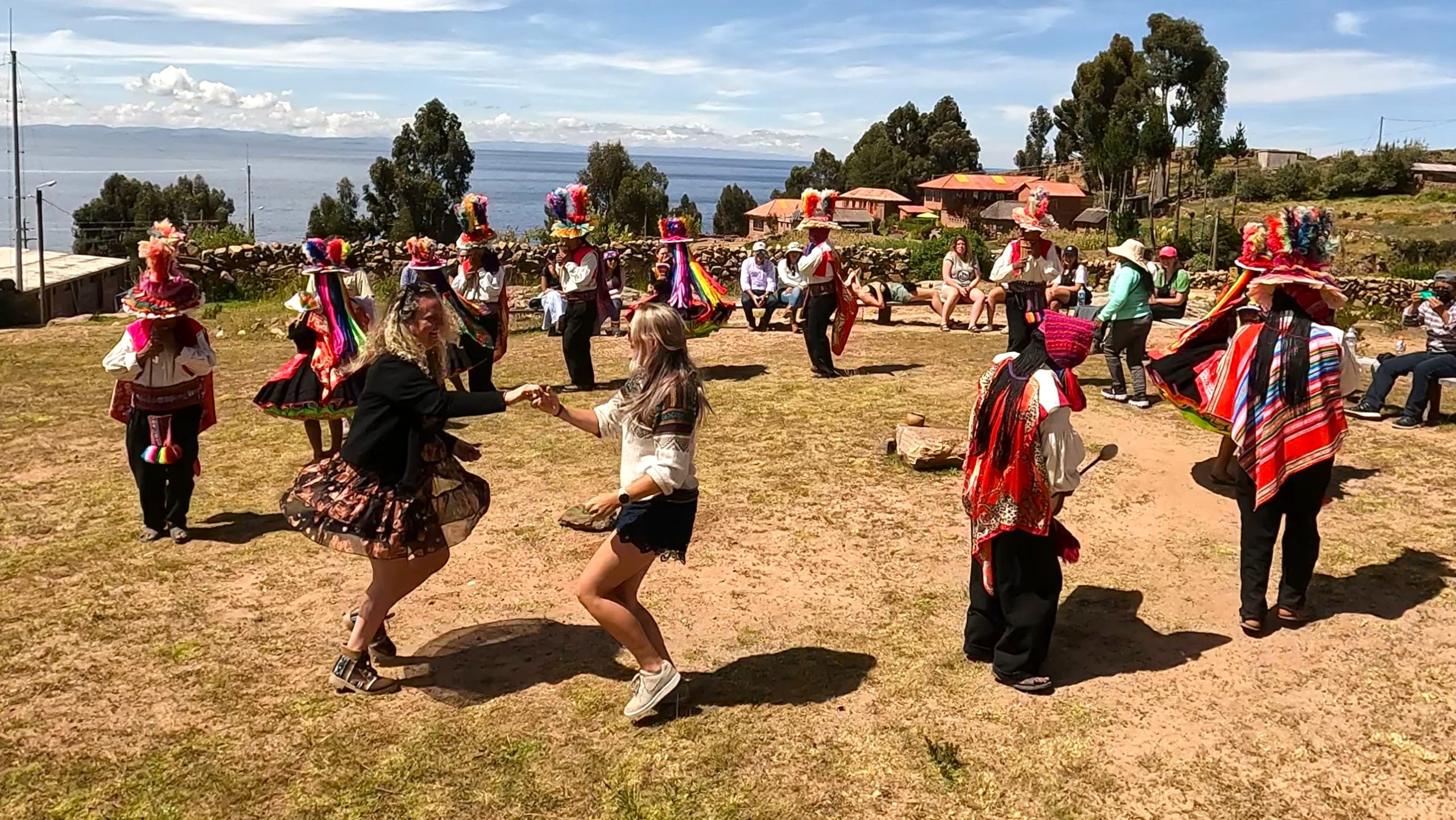
Dancing the Peruvian dance
After that we walked on the beautiful landscape towards a restaurant where we had a lunch. After lunch I quickly ran to the beach to take a foot bath in the highest largest lake. This was my once-in-a-lifetime opportunity. The water was unfortunately too cold for a swim (9 degrees).
The people here on this island and at Uros looked so happy and were so kind. I saw a big difference with the people from the city. I asked a mother with her daughter if they were happy and why. She said she is very happy here. She actually came from the city, but choose to live her. She’s happy with the loving community she has here, that it’s a simple live … harvesting their own food and with an amazing view over the lake. It looks like that’s the key for a happy life…simply simplicity! Like the saying “simple life, happy life”